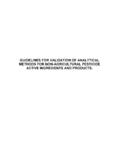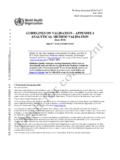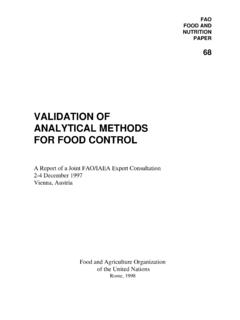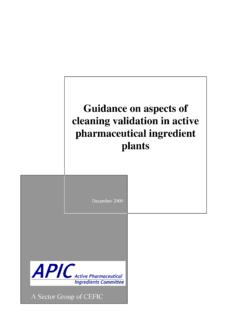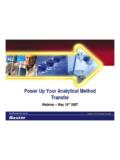Transcription of DRAFT GUIDANCE DOCUMENT ON SINGLE …
1 DRAFT 30 April 2013 1 DRAFT GUIDANCE DOCUMENT ON SINGLE LABORATORY validation OF QUANTITATIVE analytical METHODS IN SUPPORT OF PRE- AND POST-REGISTRATION DATA REQUIREMENTS FOR PLANT PROTECTION AND BIOCIDAL PRODUCTS INTRODUCTION 1. Accurate, precise and specific quantitative analytical methods are required for confirmation of identity, purity and stability of active substances (AS), and/or significant ( relative to AS) or relevant (of toxicological, ecotoxicological or environmental significance) impurities (at any concentration) in technical materials and preparations containing active substances.
2 2. This guideline is based on existing GUIDANCE documents and best practices from agencies and professional organizations pertinent to SINGLE laboratory validation of quantitative analytical methods. - SANCO/3030/99 , 11 July 2000 (1) provides GUIDANCE for generating, validating ( SINGLE laboratory validation ) and reporting quantitative analytical methods in support of registration data requirements for the European Community. - APVMA GL69 October 2004 (2) provides GUIDANCE for generating, validating ( SINGLE laboratory validation ) and reporting quantitative analytical methods in support of registration data requirements for Australia.
3 - AOAC, CIPAC, ISO and IUPAC (3) have published guidelines, in some cases harmonized guidelines, for SINGLE laboratory validation of quantitative analytical methods. 3. SINGLE laboratory validation is the logical conclusion to the method development process and provides assurance that the method has met specific requirements of performance. By its nature, a SINGLE laboratory validation does not provide data on the expectations for the method when used by other laboratories. A SINGLE laboratory validation may precede a more rigorous multi-laboratory collaborative validation or method transfer study.
4 Neither of these is addressed in this guideline. PARAMETERS FOR METHOD validation 4. Method validation is a series of quality tests involving the quantitation of an analyte or analytes in a specific sample matrix using a specific laboratory procedure and measurement system. The validation data verifies that the laboratory procedure and measurement system are suitable to the purpose of the analysis. The parameters to be determined and the acceptance criteria differ slightly according to the analyte (active substance or impurity) and the sample (technical material or preparation).
5 The validation process obtains performance data on the following parameters: a) Specificity (Selectivity) The ability of a method to distinguish between the analyte (active substance or impurity) being measured and other substances in the sample matrix. DRAFT 30 April 2013 2 b) Linearity The ability of a method to produce an acceptable linear correlation between the measured response and the concentration of the analyte in the sample. c) Accuracy (Recovery) The degree to which the measured value for the analyte in a sample corresponds to the accepted, true or reference value.
6 D) Precision (repeatability) The closeness of agreement independent test results with the same method, on identical test material, on the same equipment, by the same operator, in the same laboratory within short intervals of time. e) Limit of Quantification (LOQ) The lowest concentration of analyte in a sample that can be determined or quantitated with acceptable relative standard deviation. f) Limit of Detection The lowest concentration of analyte in a sample that can be detected, but not necessarily quantitated as an exact value. TECHNICAL MATERIALS Determination of active substances and impurities 5.
7 The method validation parameters for methods to determine active substance(s) in technical materials are: a) Specificity (Selectivity) The degree of interference in the determination of impurities in the technical material is reported. Interferences from impurities should not contribute more than 3% to measured response of the target analyte. If the active substance is specified as being optically pure, the method must support this. Where an active substance consists of more than one isomer, analogue, etc., the method should be capable of determining the individual components present, with the exception that this requirement does not include determination of optical isomers in racemic mixtures, or isomers which are more or less equally active.
8 For details of confirmatory techniques, see paragraph 7. b) Linearity The analytical calibration should extend over a range appropriate to the lowest and highest nominal concentration of the analyte in relevant analytical matrices + at least 20%. Either duplicate determinations at three or more concentrations or SINGLE determinations at five or more concentrations, is made. The equation of the calibration line and the correlation coefficient (r) must be reported and a typical calibration plot submitted. The limits of the linear range should be given, in % w/w.
9 Where a linear correlation coefficient (r) is < , an explanation of how accurate calibration is to be maintained should be submitted. Where a non-linear calibration is used, an explanation (including how calibration accuracy is to be maintained) is provided. c) Accuracy (Recovery) The determination of accuracy for the active substance in the technical material is not required. An assessment of the accuracy of the method can be made through the assessment of interference and precision. d) Precision (repeatability) Details of the precision of the method are required for the active substance in the technical material.
10 A minimum of five separate sample determinations is made and the mean, % RSD and number of determinations reported. The acceptability of the % RSD may be assessed using the modified Horwitz equation (details are given in Appendix). Where outliers have been identified using appropriate statistical methods (such as Dixon s or Grubbs Test) this should be made clear and justified. A maximum of one outlier may be discarded at each DRAFT 30 April 2013 3 fortification level. Where more than one outlier has been identified, additional determinations must be included.











